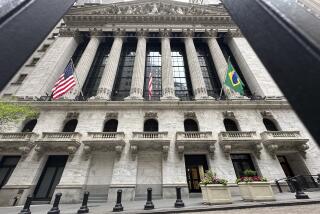Blue-Chip Love Fest
- Share via
Valuations on U.S. blue-chip stocks are sky-high. Deal with it.
Sure, that sounds blunt. But investors don’t have much choice, many Wall Streeters argue.
Despite a 4-year-old rally that has pushed blue-chip price-to-earnings ratios and other valuation measures to historically high levels, investors continued to swarm into many of these stocks in the second quarter. And the trend seems likely to continue near-term.
On paper, investors have any number of reasons to be wary of the largest-capitalization stocks: Earnings growth has slowed for many. The Asian financial crisis has worsened, further threatening multinational companies’ profits. And the dollar is surging, eroding U.S. competitiveness.
“Valuation keeps getting stretched and stretched,” said Scott Schermerhorn, manager of the Federated American Leaders fund in Pittsburgh.
Investors who remain blue-chip enthusiasts see it differently, of course. To them, major U.S. multinational companies--such as Microsoft, Coca-Cola and Merck--are worth these prices because they are tops in their fields worldwide. Old valuation rules no longer apply, the stocks’ fans say.
What’s a small investor to do?
It’s tough to justify selling out of large-cap stocks altogether. Indeed, some Wall Streeters believe they’ll lead the market until at least the next recession--and that’s not on the immediate horizon.
The key is to be selective, experts say. And make sure the big-name stocks you own are rising because their fundamentals are strong, not because the market is simply reaching for any well-known name.
“It’s OK to pay a high [price-to-earnings ratio] as long as you’re getting the earnings to back it up,” said Jonathan Lee, managing partner at Hollister Asset Management in Century City.
With one day to go in the second quarter, the blue-chip Standard & Poor’s 500-stock index is at a record high, and up 17.3% year-to-date.
By contrast, the Russell 2,000 index of small-capitalization stocks has fallen 5.6% in the quarter and is up a feeble 3.8% year-to-date.
What’s more, large-cap stocks demonstrated their dominance as the S&P; slipped less than 5% when the market swooned from mid-April to mid-June, while the Russell gave up almost 12%.
Many theories have been trotted out in the last few years to explain the large-cap love fest, and they’re all more or less true.
Major U.S. companies have slashed costs and boosted efficiency in recent years. Blue-chip earnings soared between 1994 and 1997. And in many industries the United States’ largest players now are the global leaders as well.
But how long can the good times last--and how high a price should you pay for these stocks?
The S&P; 500 index’s price-to-earnings (P/E) ratio now is about 24, based on the most recent four quarters of operating earnings. Use reported earnings--after one-time charges--and the P/E is near 27.
In comparison, the peak P/E on reported earnings in August 1987, just before the market crash, was about 24.
Some analysts argue that large caps now are being propped up by the herd mentality of Wall Street, and little more. Big-name stocks have performed so well for so long that pros keep pouring money into them. In effect, mainstream managers have joined the ranks of the much-maligned momentum players, some critics contend.
If a portfolio is going to sag, many managers figure it’s better to have it crammed with recognizable names than with obscure smaller stocks that could leave the managers open to second-guessing by shareholders.
“Large caps are pretty doggone expensive relative to small caps, but people are still chasing yesterday’s performance, and it can go on longer than you think,” said Jonathan Schoolar, a manager at AIM Management Group in Houston.
“But ultimately it’s a sucker’s bet,” he warns.
*
Pinpointing where valuations will peak, however, is proving to be a very tough call, as usual.
Gurudutt Baliga, manager of the IDS Blue Chip Advantage fund, sold Microsoft and Dell Computer on the reasoning that they were too pricey--and then watched from the sidelines as they kept rising.
“It’s been one of the most painful lessons in this market,” Baliga said. Sometimes investors must “close your eyes and hold your nose and let these things ride.”
The irony is that today’s type of market environment has historically been negative, not positive, for large stocks. The age of the economic expansion, the severity of the Asian crisis and the dollar’s strength have raised doubts about near-term earnings growth at many U.S. multinationals.
Such giants as Intel, Hewlett-Packard and Boeing have already disappointed Wall Street in recent quarters with weaker-than-expected earnings.
By contrast, U.S. small-company profits, overall, have been rising at a faster pace than blue-chip earnings since last summer, in part because many smaller companies lack significant foreign exposure.
Yet demand for many blue-chip stocks has remained far stronger than demand for smaller stocks.
One explanation is that worries about the global economy have caused American and foreign investors to huddle into the perceived safety of big U.S. stocks.
A recent Lehman Bros. study confirms what investors already believed: Overall, the long-term profit stability and predictability of large-cap issues are superior to that of smaller stocks.
*
But isn’t there an argument that this large-cap rally is a bubble that will eventually burst?
Many of the stocks’ fans argue that there is no bubble--yet. Yes, P/Es are high, but stocks are judged in part against long-term interest rates, and rates are at 30-year lows--so P/Es should be historically high. (Rates were far higher in 1987.)
What’s more, the opening of foreign markets in the 1990s, and the increased ability of U.S. firms to hedge against forces such as currency shifts, should mean that multinational leaders’ stocks carry higher premiums than 10, 20 or 30 years ago, supporters say.
That’s the argument that the old rules don’t apply--for example, that a stock shouldn’t sell for a higher P/E than its expected annual earnings growth rate.
Some portfolio managers simply view some of the classic consumer growth stocks as such strong global players--and offering such great long-term potential--that their prices are fully justified.
Hollister’s Lee, for example, pays attention to net profit margins, which measure how much companies keep of every dollar of revenue they take in.
Lee likes Coca-Cola, even though it trades at 53 times estimated 1998 earnings, a whopping 3.2 times its profit growth rate.
Lee wouldn’t necessarily buy more at today’s prices, but he wouldn’t sell, either, he says. His reasoning: Coke’s profit margins are fantastic. Its annual net margin over the last 10 years has averaged 17%.
He also likes drug giant Merck. In the last decade, Merck’s lowest annual net profit margin was 19.6%, Lee said. And that was in 1996, when the company took a big one-time charge.
Walter Hamilton can be reached by e-mail at [email protected].
(BEGIN TEXT OF INFOBOX / INFOGRAPHIC)
Big-Cap Leaders
Here are year-to-date price gains for a select list of blue-chip stocks, as well as the stocks’ price-to-earnings ratios based on estimated 1998 earnings per share, and analysts’ consensus estimates of annualized EPS growth over the next five years. Earnings estimates are from IBES International.
*--*
Monday YTD ’98 5-yr. est. Stock close gain P/E EPS growth Dell Computer $94.13 +124.1% 48 29% Microsoft 107.44 +66.2 51* 24 Wal-Mart 62.06 +57.4 34 14 Pfizer 109.94 +47.5 53 18 McDonald’s 69.19 +44.9 28 14 Coca-Cola 86.00 +29.0 53 16 Merck 132.75 +25.2 31 14 American Express 111.69 +25.1 24 14 General Electric 90.88 +23.8 32 13 Exxon 71.50 +16.8 25 7 Procter & Gamble 92.19 +15.5 32* 13 Walt Disney 113.19 +14.3 37 18 Fannie Mae 62.81 +10.1 20 13 Intel 75.81 +7.9 24 20 J.P. Morgan 118.75 +5.2 15 10 S&P; 500 1,138.49 +17.3 24 NA
*--*
* Based on estimates for fiscal years ending June 1999
Source: Bloomberg News
More to Read
Inside the business of entertainment
The Wide Shot brings you news, analysis and insights on everything from streaming wars to production — and what it all means for the future.
You may occasionally receive promotional content from the Los Angeles Times.










